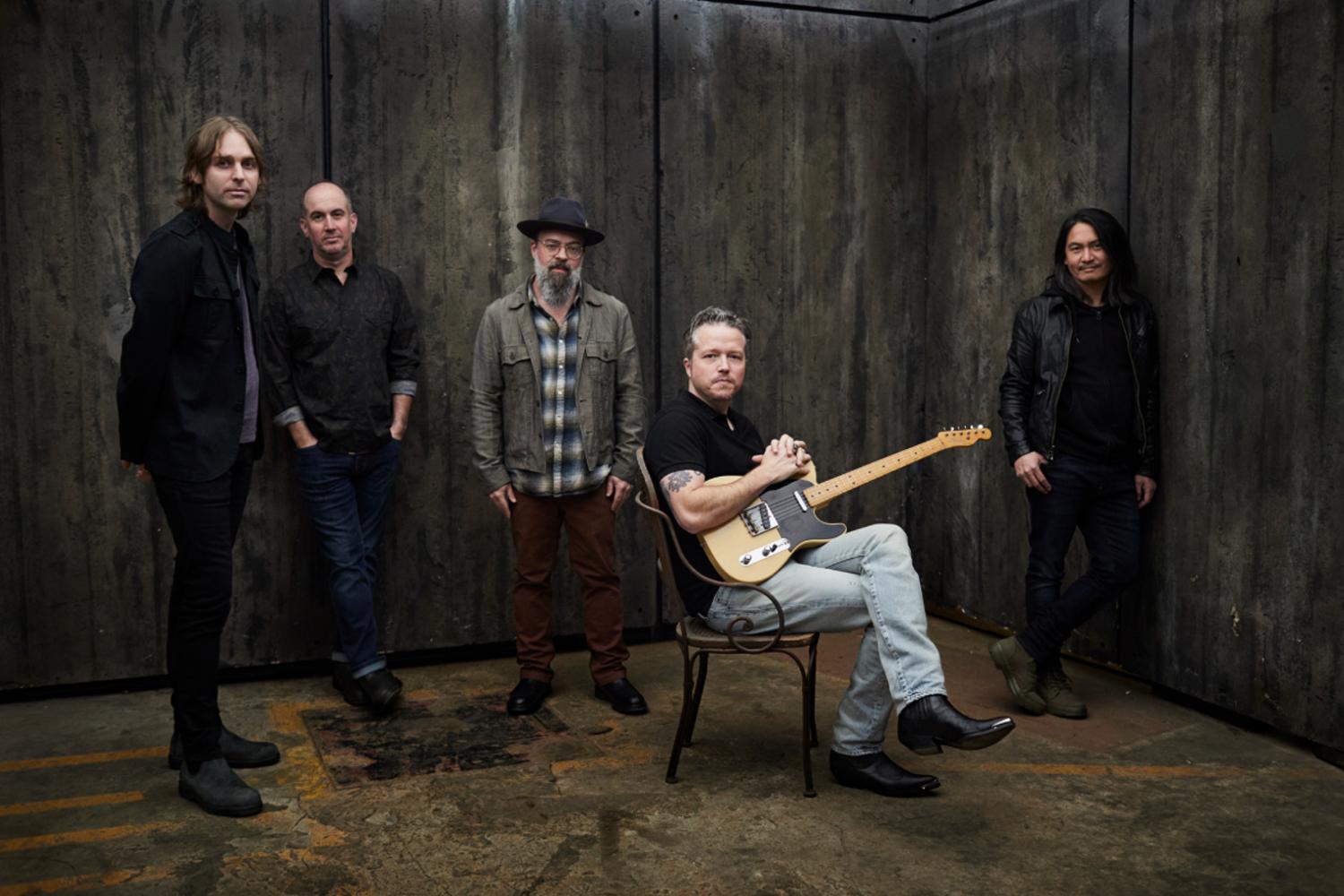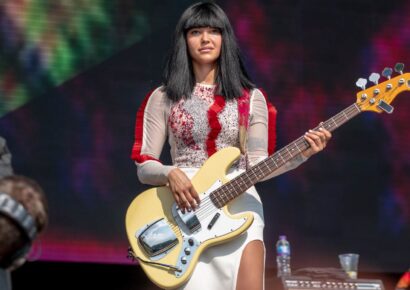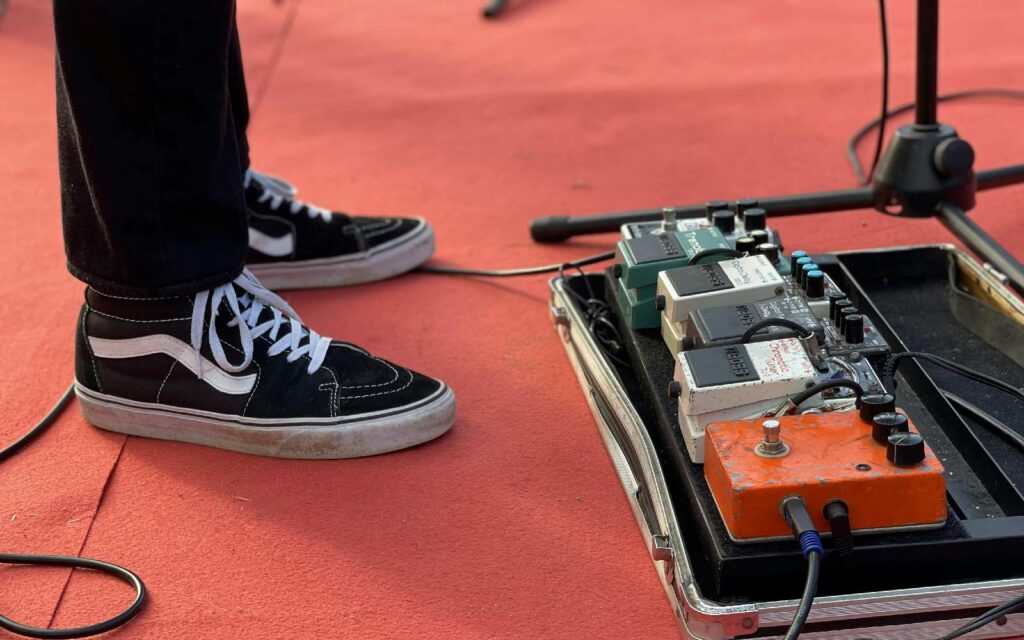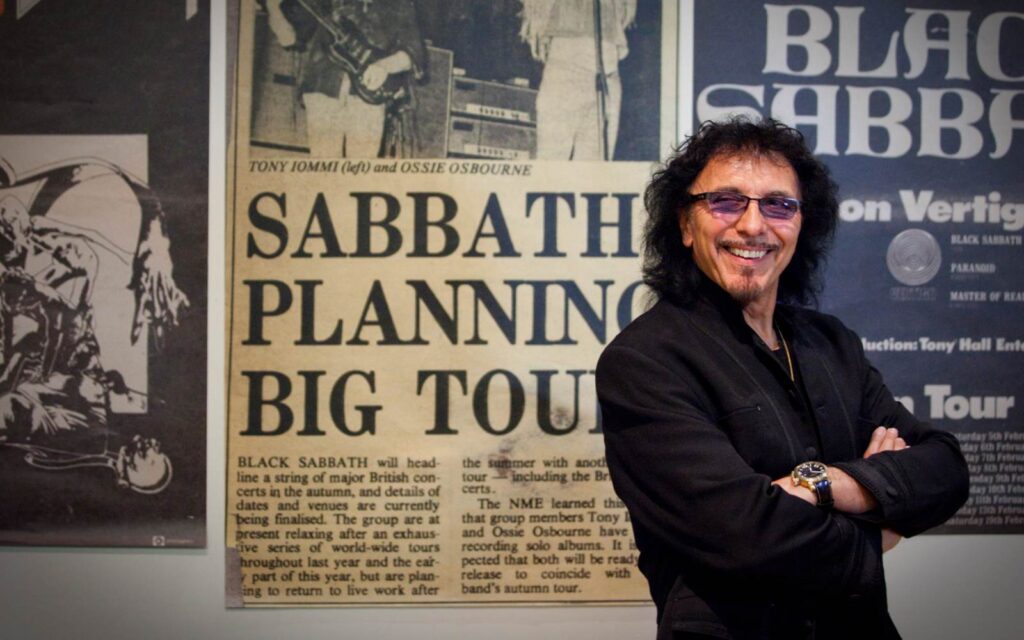Back in 2023 we spoke to Jason Isbell his album, Weathervanes, his monstrous but efficient touring rig and recording at Blackbird Studios in Nashville.
Jason Isbell is somewhat of an enigma. He’s equally comfortable as a session musician, band member and singer-songwriter – ultimately resulting in his fronting Jason Isbell and the 400 Units, a band made up of some of the best rock, Americana and country musicians that the USA has to offer. Their new album, Weathervanes, is available now and speaks to all of these incredible skills in just nine songs. Sitting down with Jason to discuss the record, Mixdown began by explaining we have an equipment focused audience – and he seemed excited to dive into it all.
The title Weathervanes, Jason explains, refers to his role as a spouse and parent.
Read up on all the latest interviews here.
“Y’know, [a] weathervane is a device that shows you which way the wind is coming from, so by itself it doesn’t actually predict anything, it just tells you what’s happening. So y’know, you use that information to predict what’s going to happen next, and you use your own intuition to determine how you want to handle that.
And I feel like, sometimes that’s the job of a songwriter, y’know, I think it’s also the job of a parent, or a partner or spouse or a friend, sometimes just giving you a realistic portrayal of which direction the wind is coming from is really the best that we can do as an artist.”
The artwork displays a weathervane with the traditional N, S, E and W replaced with two S’s and two E’s, a tribute to his record label and record Southeastern.
“My record label is called South Eastern, we named it after the record, the Southeastern album that I put out a decade ago, and we named it after the Southeastern record that we put out a decade ago yesterday.” A huge milestone.
Jason is the primary songwriter for the band, explaining, “Yeah, I write ‘em all on my own, and I bring ‘em in and play ‘em for everybody. And, uh, then we all sit down and start playing together… Sometimes we’ll build the song from a drum track, or… some kind of basic rhythm track and then we’ll go from there. For the most part we sit down and we start playing, and then if somebody needs to overdub something then we’ll do that. Usually we try to get a good drum track and a good bass guitar track, and then we go from there.”
A whole band all playing at once can lead to a lot of bleed, sacrificing control over the recorded takes, however Jason tells me: “most things are iso[late]d. We were at Blackbird Studios in Nashville, and that’s a pretty big, sort of sprawling facility, so we had plenty of space. Yeah, so we had two separate drum rooms, we had one where the drums were isolated and then one where they were out in the recording floor. That main recording room was a reverb chamber also so the ceiling was treated and it was really tall. Yeah, it worked out nicely, sometimes we would switch between the two drum kits and there’s a couple places where both kits are on at once. Yeah, so we had a lot of fun with that.”
I mention that I’ve watched countless videos about the reverb chamber at Blackbird Studios; the ceiling on a pulley system that can tighten or liven the space, changing the reverb time. I feel Jason’s energy shift positively here. “Yeah, yeah that’s it.” he says with a smile.
We move onto more recording specific questions, Jason explaining that he produced the record, and I ask how he views his role – whether he’s predominantly a songwriter, producer or guitar player.
“Y’know, I mean I guess I’m probably a songwriter more than anything else. I mean, I still feel like a guy that plays guitar in a rock band, more often than not. Y’know, the songs are what really matters about, y’know, when it comes to the things that I do for a job, the songs are the most important part, so I have to think of myself as a songwriter first.
But then once that’s done, once I have some songs that I can believe in, then I get to do things like play guitar, produce a record and have fun playing with the toys.”
The toys are what we here at Mixdown are always most interested in, so I ask about some of the key pieces used to record Weathervanes.
“That’s a big question, we had a lot of good stuff though, man. I mean, Gena Johnson and Matt Ross-Spang were my engineers and they both worked on some incredible records, y’know all kinds of good stuff… but we had a nice 80s series Neve and a whole bunch of really good amps, y’know, I have a pretty good collection of guitar amplifiers.”
“Blackbird has a microphone list that looks like the wine list at Lapérouse, like a three-ring binder. Yeah it’s ridiculous… they have everything you could imagine in there. So y’know, we had all the gear that you could possibly want. Um, but ah, for me there was a ‘53 Telecaster that I used on a whole lot of stuff. It’s on ‘This Ain’t it’ and uh, it’s on, um, ‘When We Were Close’ and, y’know it just sort of, I mean that sort of guitar works on a whole lot of different settings, and then I have a 1959 Les Paul that also came into play quite a bit, y’know.”
I interrupt here — to confirm that this is the famous ‘Red Eye’ Les Paul, a unique 1959 Burst owned by Ed King of Lynyrd Skynyrd.
“Yeah, that’s the Red Eye yeah, that was most of my lead guitar playing, y’know a lot of the slide parts and the duelling guitar and stuff. Yeah, I mean, I guess if there’s one piece that kind of made it all work, y’know, it would probably be that Telecaster. I think that’s the thing that I had in my hand the most when I was writing and recording the album.”
I pause the questions for a moment to agree that the Telecaster can sit nicely amongst an arrangement, not requiring much work in the mix.
“It can be a really great rhythm instrument, or a lead instrument which is kinda rare. Y’know, if you play a Les Paul, it’s gonna take so much space in the mix, then it’s gonna dominate sometimes. But a Telecaster, you can use it to be just delicate and underneath everything else or you can cut through the mix with it. It’s an extremely versatile guitar.”
It’s interesting that someone with such a massive collection of guitars would opt to record an album with one primarily, and I ask about whether he prefers having plenty of options, or if he could get the job done with just one.
“Hopefully we’ll never know the answer to that question.” Jason laughs.
“I like having a bunch of guitars and amps and stuff, it’s fun. Honestly, I could do it with one, y’know, if I had just a 335 and a good amp, I could do that, but um, or a Tele, probably I could make my whole career with just a Telecaster. But, the fact is, there are certain times when you just really wanna hear a Les Paul, or you really wanna hear a Strat. There are some guitar parts that just sort of demand that. A big part of my career has been switching between acoustic guitar and electric guitar. That’s something I do a lot live, and a lot on records and stuff. And, I try to approach them differently, I think some of my favourite guitar players, they play to the instrument that they’re playing, like David Rawlings who plays for Gillian Welch. David plays an acoustic guitar like an acoustic guitar, he’s not just trying to recreate electric guitar parts on an acoustic, and that’s something that I try to do. Y’know, if I’m playing a Les Paul, I’m trying to play it like a Les Paul. If I’m playing a Telecaster that’ll affect my playing also, I think for me it’s best to have at least one good example of each primary type of guitar.
We agree, laughing that it’s nice to have an excuse to buy guitars.
When asked if he’s still using his amplifiers live, without the comfort and space of the studio environment, Jason tells me:
“Yes, I am. I’ve actually got probably crazier stuff on tour than I had in the studio right now. Um, yeah, so I’ve got a primary amp rig, [which] is: a Vibroverb, ‘64 Fender Vibroverb with a 1 x 15” [speaker], and then a ‘58 high-powered Tweed Twin, um, with 2 x 12”, so that’s 80-watts. And then I’ve got two Magnatone combos, and Magnatone built these custom for me, so we could get the effects to go in before the separation, so we could put stereo effects into the amp, before the vibrato starts panning, ‘cause it actually shifts the pitch and it pans from one amp to the other. We’re using one as a slave to the other so they bounce back and forth.”
“So we can do stereo effects within the moving image of the amplifier’s vibrato, which is really cool. And then I have a Dumble Overdrive Special in the live rig, also —”
I’m stunned here, Jason casually reeling off some of the most famous amplifier and drive circuits in guitar history.
“Yeah, so it’s pretty serious. It’s pretty ridiculous.”
Five amps is all good and well in theory, but that’s a lot of air to be pushing all the time and I ask how he, and if, he toggles between them.
“So the way I have it done is my tech, Michael Bethancourt, set up a switcher that’s really similar to the old Bradshaw system, where all of my amps and all of my pedals, and also I have a Neural DSP with a backup of all my amps, and then I have a few other amps that I don’t bring on the road, in the Neural DSP to blend in with the real amplifiers. So, um, like I’ve got a couple of old, like an old [Vox] AC15 and a, ah, one of the first ten Marshall Bluesbreakers.
I’m not gonna take those on the road, ‘cause they’re just too old and too heavy and in too-good condition, uh, so I put those in the Neural DSP and then I’ll blend those in with the real amps, and then I have a rack of effects behind me, matter of fact I just recently got that Echo Fix, which is an Australian company. Yeah, it’s a tape echo and chorus and reverb, and it’s all in one box and it’s rack-mountable and it slides out and you can change the cartridges easily and it solved the old Echoplex problem where you can’t tour with one unless you have four of them, ‘cause you’re always workin’ on a couple.” Jason laughs.
“But, um, I have all the effects behind me, in the rack, and everything stays on, but then I have MIDI controlling the signal chain. So it’s basically an analogue signal chain, it’s just controlled by MIDI information. And I have a controller in front of me, so I send Michael the set list, and then he will go through and he will program each page in the controller, where y’know, I’ll just land on a song, each scene will be the song, and I’ll hit one button for the verse, one button for the chorus, and one button for the solo where it’ll route the signal chain.”
A custom switching system is something most of us can only dream of, and Jason doesn’t take it for granted.
“Yeah, it’s great. Being somebody who sings all night, y’know, it saves me a lot of trouble and a lot of effort ‘cause I’m not tap-dancing on pedals and amp switchers all night long.”
“Yeah, and I know that like, y’know, sometimes, if I want a certain tone, y’know I’ll go check it out during soundcheck, and then I’ll take something out or add it back in. Sometimes I’ll try to get as close as I can to the recording, and then sometimes I’m trying to do something completely different. Y’know, it’s a fun challenge.”
It’s important to note that Jason here is harnessing the best of the digital and analogue domains. A lot of players see analogue and digital as a fork in the road, whereas Jason’s rig is hybrid: primarily analogue circuits with switching and security from digital technology.
“Yeah, and I trust my ears. I think if you trust your ears, then you’re kind of wide open to use anything, ‘cause, like with the Neural DSP, like I listen to those amp models and they sound good to me, so I’m gonna use ‘em. I don’t love their built-in effects, so I’m gonna use actual pedals, but the way they… the way you can store an amp in there, I think it sounds fantastic, and I trust my ears. I think that’s pretty much it, if I was questioning my ears, I would just plug straight into the Dumble all night, ‘cause I know that’s gonna sound good, but I can hear it, so I feel like I can basically judge it that way.”
We chat for a moment about modelling, acknowledging that where or not the profiles sound exactly like the amp they’re trying to model, they’re still objectively good sounds.
“I think so, it also depends what you’re using it for. If I’m in the studio, I’m gonna try to use a real amp as much as possible, um, and I’m also not gonna use many pedals, like, um, I don’t use a lot of overdrive pedals, and I have all kinds of crazy stuff. Y’know, I’ve got an old Rangemaster, a couple of Klon Centaurs, and all kinds of stuff. But most of the time I don’t bring them out in the studio, just because I can turn my amp up… put the lead directly into the amp and hear it as clearly as possible. But when you’re live, everything’s going through, y’know, your front of house, and it’s going through your console and it’s all being digitised at some point for the most part before it comes back out. So, it’s the little bit of difference, when it’s coming out of the speaker, [it’s] not gonna be so obvious once it gets to the audience.”
I agree that it’s that tiny bit of difference that forces us to take the road less travelled sometimes, the difference being minute but enough to push us to make a certain pedal amp or guitar work.
“Always. It’s always the case, that’s always it. I mean, that was the problem with the Klon, y’know, there’s all these copies of that pedal that sound fantastic, but there’s this…” [Jason motions with his pointer finger and thumb, creating a tiny gap] “… much difference, and the problem is once you hear it, y’know, you can’t un-hear it, you think ‘well that’s super close’, but I’d rather just have that extra… and it doesn’t matter, I mean for the most part we’re all, it’s like a [Japanese] garden or something, where we’re just making little things in the sand and erasing them and starting over. It’s just for us to noodle around with and try to be creative.”
The fluid nature of sounds, tone and music is interesting and I like Jason’s fleeting analogy of the Japanese karesansui gardens.
“Yeah, almost alive. Something alive to it, and it changes over time, y’know, what I thought was a good live tone 20 years ago, now is very different from what I look for… and then sometimes that completely starts over. Something about me, playing with all this shit and I’ll be like ‘let’s just unplug all this shit, plug straight in and use my volume knob’ y’know?”
I agree that the impermanent nature of your tone helps you adjust for different rooms and venues anyway, night after night on a tour.
“Everything’s different. I was making a record, my wife’s, Amanda, her most recent album, we were recording it at RCA, but we were in the B-Room, which was the original RCA Studios, the one that Chet Atkins worked in for all those years. The first couple days I was trying to get the cycle hum out, the power was weird in there, and all the guitars were so noisy. Of course the Fenders were, but then when I switched to a Gibson [with humbuckers] it was the same way. So I brought in power conditioners and nothing changed. And then I brought in a Kemper, and a Fractal, same thing. Still buzzing.
Finally, the problem got solved when I played a Gretsch with Filter’Tron pickups, and that was completely silent, it sounded perfect in that room. And I thought ‘Man, I bet that’s why Chet Atkins loved Gretsch guitars so much, because they worked in that room every day, and the only thing that wasn’t buzzy’, y’know. Sometimes that tone just comes out of a practical necessity.”
We chat for a moment about how complicated we can make things like signal chain troubleshooting, or that we often assume the solution has to be this over-complicated thing. In reality there’s usually an easy way out, or a practical solution that’s hiding in plain sight.
“Yep. Yeah, it’s like making a track list. Like, I’ve answered a bunch of questions about why I put the songs in this particular order on this record, but a lot of it was because I was making a tracklist for vinyl, y’know, in the way that they did in the 70s where the songs that had the most production and most instrumentation get the deepest, widest grooves, and the songs without are close to the end. Yeah, so you start the record off with the loud songs, and gradually, as the grooves get thinner, you give ‘em less information. Yeah, it’s just a practical thing, but I think over time, we tend to listen to records that way, and we expect that to be the way that it happens, so there’s something that, I think, gets into our brains about that.”
Ending the conversation on one of the final stages of the record production process, pressing vinyl, feels natural, and I thank Jason for his time and the particularly nerdy, tech-focused chat.
“It is nerdy, yeah.” Jason laughs. “That’s not how it normally goes, so I appreciate it.”
Keep up to date with all things Jason Isbell here.







